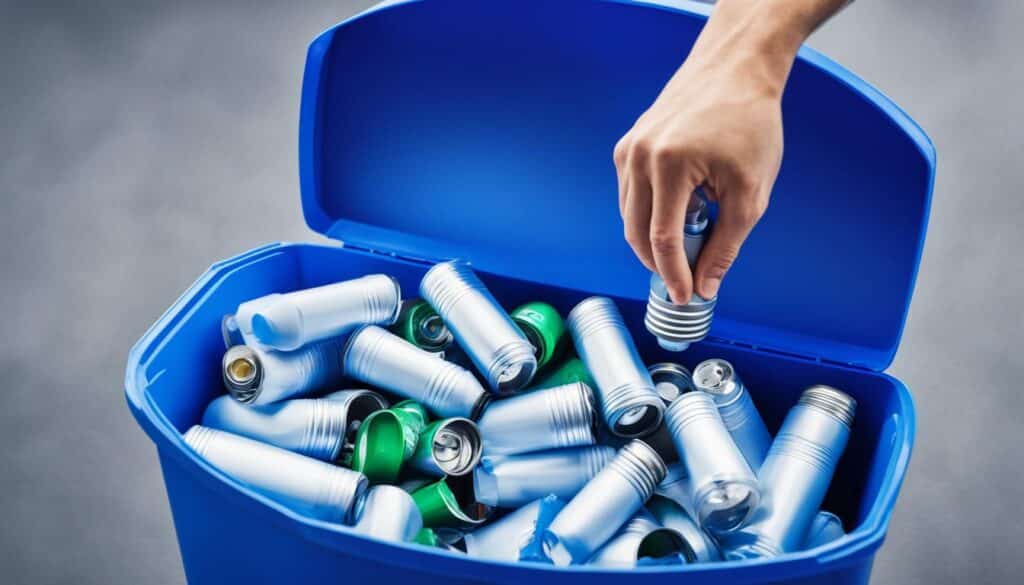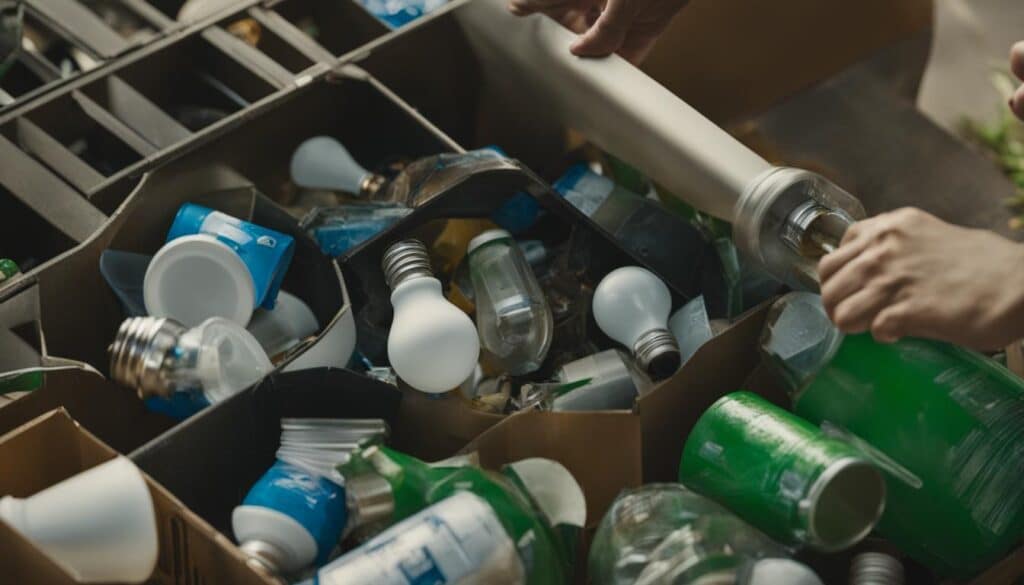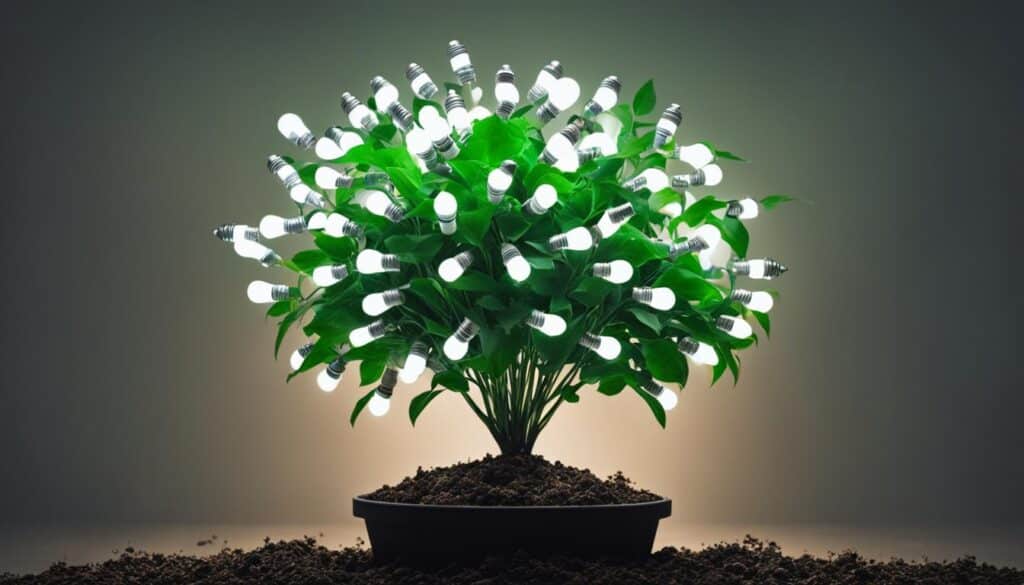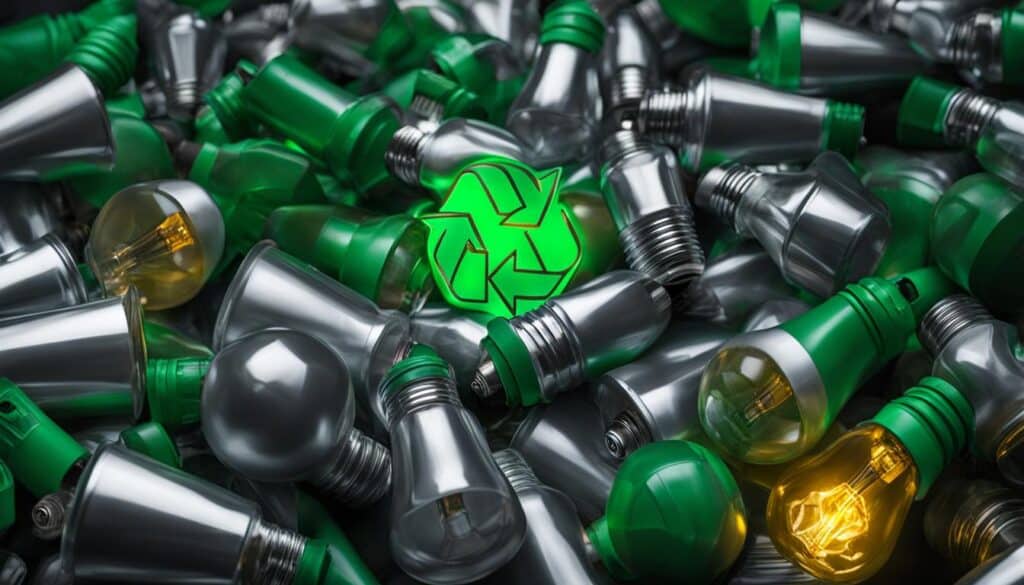In the quest for greener living and responsible waste management, many of us find ourselves asking, “Can you recycle LED light bulbs?” The answer lies in recognizing the significance of eco-friendly LED light bulb disposal. Unlike traditional incandescents, LED bulbs contain components that, while not extensively hazardous, require thoughtful handling due to trace amounts of heavy metals, such as lead and arsenic. Navigating the avenues for recycling LED light bulbs is not just about keeping these elements out of landfills; it’s about contributing to a more sustainable future.
Fortunately, there are established protocols and resources for recycling LED bulbs. Forward-thinking retailers, including The Home Depot, offer ways for consumers to bring in bulbs for proper recycling. These processes help preserve our environment by minimizing landfill waste and conserving the Earth’s finite resources. In our continuous effort to care for the planet, we take a closer look at how efficient recycling can be as straightforward as the LED lighting choices we make.
Key Takeaways:
- Eco-friendly disposal of LED bulbs keeps harmful metals out of our environment.
- Recycling LED light bulbs is a step towards sustainable resource conservation.
- Big-box retailers such as The Home Depot are pivotal in accommodating bulb recycling.
- LED bulbs boast recyclable materials, unlike traditional incandescents.
- Utilizing proper recycling avenues aligns with our environmental responsibilities.
- Informed consumers can make a difference by choosing to recycle LED bulbs.
Understanding the Importance of Recycling LED Light Bulbs
As we delve into the intricacies of LED light bulb disposal, it is critical to acknowledge the significant strides these bulbs have made toward energy efficiency. While their lifespan and energy usage are commonly hailed, it is the proper disposal of led light bulbs and the recycling options for led light bulbs that demand our attention. This is because the process plays a pivotal role in mitigating the environmental impact of led light bulbs. It is our collective responsibility to ensure that the end-of-life management of these bulbs does not undo their environmental benefits.
The Environmental Impact of LED Bulbs
LEDs have drastically changed the lighting landscape, but their improper disposal poses real threats to our planet. Mercury, a toxic element absent in LEDs, has been a major concern with CFLs. However, LEDs contain other harmful substances like lead and arsenic, which necessitate their proper recycling to prevent contamination of water and soil. By recycling LEDs, we can stop these toxins from entering landfills and leaching into our environment, thus protecting our ecosystems.
Conserving Resources: Glass, Metal, and Plastic
The construction of LED bulbs involves valuable materials such as glass, metals, and plastic, all of which can be reclaimed through recycling processes. According to GreenTech Solutions, an astonishing 95% of an LED bulb is recyclable. We stand to conserve significant amounts of these materials, which can then be repurposed to manufacture new products, reducing the need to extract raw resources—a win for both the economy and environment.
The Difference Between LED and Incandescent Bulbs
When compared to their incandescent counterparts, LED bulbs are championed for their lower energy requirements—up to 90% less. This efficiency translates to reduced greenhouse gas emissions from power plants, but the benefits don’t stop at energy savings. Unlike incandescent bulbs, the material composition of LEDs inclines them towards recycling, rather than trash disposal. This fundamental distinction makes LEDs not only an energy-wise choice but also a more recyclable one, reinforcing their position as a sustainable lighting solution.
Ultimately, the journey of an LED bulb from shelf to disposal is laden with opportunities to minimize environmental harm. As consciousness about our ecological footprint grows, so does our understanding of the need for proper recycling practices. With multiple recycling options for LED light bulbs now available, there is no excuse to eschew responsibility in favor of convenience. Let’s continue this dialogue as a community committed to sustainability and ensure that eco-friendly practices illuminate our future.
Can You Recycle LED Light Bulbs?
As custodians of our planet, we’re often asked, “can you recycle LED light bulbs?” The answer is a resounding yes, and in fact, we highly recommend it. Although LED bulbs are praised for their energy efficiency and longevity, they eventually burn out. When this happens, it’s important to note that LED bulbs are not to be tossed into the regular trash due to their electronic components that may contain heavy metals. Thankfully, how to recycle LED light bulbs is becoming increasingly straightforward thanks to accessible local recycling programs.

To facilitate LED light bulb recycling, many retail outlets including Lowe’s, Home Depot, and IKEA have stepped up to provide drop-off points for consumers. Additionally, Batteries Plus and certain hardware stores offer recycling services, sometimes for a nominal fee. To further aid in this endeavor, below we have compiled a table that provides clarity on where you can bring your LED bulbs for recycling:
| Location | Type of Service | Fee | Notes |
|---|---|---|---|
| Home Depot | In-Store Recycling | No Fee | Drop-off bins available at Customer Service |
| Lowe’s | In-Store Recycling | No Fee | Designated recycling areas |
| IKEA | In-Store Recycling | No Fee | Recycle any brand of LED |
| Batteries Plus | Recycling Service | Potential Fee | Contact local store for details |
| Local Hardware Stores | Recycling Service | Varies | Check availability and fees |
| Municipal Drop-Off | Local Recycling Program | No Fee | May have specific dates and locations |
We encourage you to leverage these options to ensure the safe and eco-friendly disposal of your LED light bulbs. Remember, by recycling, we not only remove harmful materials from the waste stream but also reclaim valuable resources that can be used in the production of new products. Let’s continue to light our homes responsibly and sustainably.
How to Prepare LED Bulbs for Recycling
When it’s time to recycle LED light bulbs, proper preparation is key to ensure safe and efficient recycling. The process starts at home, and we can all contribute to responsible recycling by following a few simple recycling guidelines for LED light bulbs. Let’s walk through the steps to prepare your LED bulbs for recycling.
Safe Removal and Handling of LED Bulbs
Before anything else, make sure that the LED bulbs have cooled down after use. Gently unscrew each bulb from its fixture and inspect it for any damage. Intact bulbs should be handled with care to prevent breakage which can pose safety risks and complicate the recycling process.
Wrapping and Packaging for Transport
To transport your bulbs to a recycling facility or drop-off location safely, wrap each bulb individually in newspaper or bubble wrap. Placing them in a sturdy cardboard box minimizes movement and further reduces the risk of breakage. If you have the original packaging, it’s an excellent option for safe transport.
Separating Components for Specialized Recycling
In some cases, LED bulbs may contain components that need to be recycled separately. Before you take your bulbs to a facility, check if there are any special instructions for components like batteries or detachable parts. Separating these elements out could make the recycling process more effective.
| Component | Action Required | Reason |
|---|---|---|
| Glass | Wrap individually | Prevents breakage and injury |
| Plastic/Metal Base | Detach if possible | Separate recycling streams |
| Electronics | Remove batteries or PCBs | Specialized recycling requirements |
Recycle LED Bulbs Safely: A Step-by-Step Guide
As stewards of a greener planet, we realize the importance of proper disposal of led light bulbs, ensuring that each step we take is aligned with eco-conscious practices. It is crucial to recycle led bulbs safely, reducing environmental harm and promoting sustainability.
Identifying Local Recycling Options for LED Bulbs
Our first course of action involves pinpointing local facilities that welcome LED bulbs. The U.S. Environmental Protection Agency (EPA) provides an encompassing list of setting-friendly options. Inputting our zip code on their website unveils nearby recycling centers, alongside the specific services they offer. Such knowledge is paramount, as we advocate for responsible recycling habits within our community.
DIY Ideas: Upcycling LED Bulbs
Creative spirits may find joy in upcycling non-functional LED bulbs. The internet is a treasure trove, replete with ideas transforming these bulbs into artful decorations. From terrariums to unique vessels for salt and pepper shakers, the possibilities are both endless and inspiring. Upcycling not only gives a second life to these objects but also enriches our living spaces with a touch of environmental consciousness.
What to Avoid When Recycling LED Bulbs
Not all methods of disposal align with the notion to recycle led bulbs safely. It is of the utmost importance to avoid tossing LED bulbs into household trash. They could potentially pose an ecological risk, releasing harmful elements into our treasured environment. Knowing what to shun is as critical as recognizing the right steps to take, ensuring our commitment to eco-friendly practices remains steadfast and pure.
Below, find a table outlining vital dos and don’ts guiding us through the maze of proper disposal of led light bulbs:
| Do’s | Don’ts |
|---|---|
| Check with local retailers for recycling programs | Dispose of LED bulbs with regular waste |
| Visit the EPA website for approved facilities | Ignore potential toxins in LED bulbs |
| Consider creative upcycling ideas | Miss out on the opportunity to repurpose LED bulbs |
By adhering to these guidelines, we can all contribute to a healthier, more sustainable world. Let us continue to share our knowledge on how to recycle led bulbs safely, propelling a movement towards wiser waste management.

Where to Recycle LED Light Bulbs
As environmentally-conscious consumers, we understand the significance of finding the right recycling options for LED light bulbs. It’s crucial to ensure that these items do not end up in landfills, where their components can be damaging to the ecosystem. Therefore, we’ve compiled a list of places where you can recycle LED light bulbs responsibly.
Home improvement stores have become valuable allies in our recycling efforts. These retailers recognize their role in environmental stewardship and offer convenient drop-off points for your used bulbs:
- Home Depot
- Lowe’s
- IKEA
In addition to these, there are other establishments like hardware stores and municipal safety departments that may provide recycling services. It is advisable to contact them ahead of time to confirm their participation in such programs. For instance, Batteries Plus offers a recycling service, though it may come with a fee.
For those who do not have access to local drop-off centers or are looking for the utmost convenience, mail-in services present a viable solution. It is as simple as sending off your LED bulbs to a designated facility that specializes in their safe and effective recycling. When opting for mail-in services, make sure to package your bulbs securely to prevent breakage and to ensure they arrive intact for processing.
Explore these options to find the most suitable method to recycle led light bulbs in your area. By doing so, we not only contribute to the well-being of our planet but also participate in a crucial movement towards sustainable living.
Eco-Friendly LED Light Bulb Disposal
When the time comes to say goodbye to our faithful LED light bulbs, we must ensure that our environmental footprint is as minimal as possible. The path to eco-friendly led light bulb disposal is straightforward but crucial in maintaining the balance of our ecosystem. Here’s what we must know.

Why You Shouldn’t Throw LED Bulbs in the Trash
Although it may seem harmless, tossing non-functional LED light bulbs into the bin can have adverse effects on our environment. These bulbs comprise materials and electronics which, if not disposed of properly, can release harmful substances. Specifically, the issue with proper disposal of led light bulbs lies in their content of heavy metals that should not enter landfills and potentially contaminate our ecosystem.
Locating Hazardous Waste Drop-Off Locations
Luckily, we don’t have to navigate the disposal process alone. Finding a local hazardous waste drop-off location is made easy with resources such as the EPA’s website, which we recommend checking for the most up-to-date and convenient options around us. Remember, even though LEDs are not officially classified as household hazardous waste, they still require careful handling to ensure they don’t end up harming mother nature.
| Material | Can It Be Disposed in Trash? | Suggested Disposal Method |
|---|---|---|
| LED Bulb Glass | No | Hazardous Waste Facility |
| LED Bulb Metals | No | Recycling Center |
| LED Bulb Electronics | No | Take-Back Programs or Special Recycling Events |
Through our efforts in following these guidelines, we contribute to a movement towards a cleaner and more sustainable world—one eco-friendly LED light bulb disposal at a time.
The Process of LED Light Bulb Recycling
When it’s time to say goodbye to your old LED light bulbs, knowing how to recycle led light bulbs is crucial for both environmental protection and resource conservation. The recycling process for these bulbs, which we’ll guide you through, involves several technically advanced steps that are designed to responsibly repurpose the materials.

The first phase in the recycling of LED light bulbs involves shredding the bulbs to separate the various components. This process breaks the bulbs down into smaller pieces, making it easier to sort the different materials. Next, sophisticated separators like eddy current sorters and photopic separators are introduced. These machines are finely tuned to distinguish between glass, plastic, and different types of metal. By employing these technologies, recycling centers can efficiently segregate materials and prepare them for their next life.
| Material | Separation Process | Possible Repurposing |
|---|---|---|
| Glass | Photopic Separators | Insulation, fiberglass |
| Plastics | Manual Sorting, Water Separation | Construction materials, plastic goods |
| Metals (Copper, Aluminum) | Eddy Current Separators | Wiring, piping, auto parts |
| Circuit Boards | Manual Disassembly | Electronic components, art |
Extracting metals such as copper and aluminum from shredded bulbs is one of the most valuable steps. These metals can be melted down and used to make a wide variety of new products. Additionally, the circuit boards found in LED light bulbs are a treasure trove of different metals that can be retrieved and reused. By adhering to established recycling guidelines for led light bulbs, we can reduce waste and support the manufacture of new, sustainable products.
Recycling LED light bulbs might seem like a small step, but it contributes significantly towards reducing our ecological footprint. We encourage you to follow these guidelines and support the circular economy where nothing goes to waste.
Recycling Options for LED Light Bulbs at Home Improvement Stores
As we strive for environmental stewardship, it’s reassuring to see that many home improvement retailers have embraced their role in promoting eco-friendly practices. The process of recycling LED light bulbs has been made simpler and more convenient through the deployment of in-store recycling initiatives by stores such as Lowe’s, Home Depot, and IKEA. These programs exemplify the responsibility and convenience offered to consumers, ensuring that the transition to sustainable living is as seamless as possible.

In-Store Recycling Programs: How They Work
In-store recycling programs are a testament to the practical recycling options for LED light bulbs in our community. Customers can bring their spent LED bulbs to participating stores, where dedicated recycling bins are available. The bulbs collected are then handled by specialized recycling facilities that can safely break down and repurpose the various components of LED lighting.
Responsibility and Convenience: The Role of Retailers
Home improvement stores are not only at the forefront of supplying LED light options but also play a crucial part in the bulb’s lifecycle by offering recycle LED light bulbs services. They have integrated environmental responsibility into their business models, providing an accessible recycling point that encourages consumers to responsibly dispose of LED bulbs. This vital service underscores the commitment of retailers to minimize waste and support sustainable resource use within our communities.
Proper Disposal of LED Light Bulbs: Legal and Safety Considerations
Environmental stewardship calls for us to consider the proper disposal of LED light bulbs seriously. LED bulbs are praised for their efficiency and longevity, yet their disposal comes with unique challenges. While they are not categorized as hazardous waste, there’s an emerging consensus on following specific recycling guidelines for led light bulbs to minimize potential environmental and health risks.
Navigating Local and Federal Regulations
Understanding the regulatory environment is vital when disposing of LED light bulbs. Federal guidelines may not strictly categorize LEDs as hazardous, but local regulations can vary and may impose stricter disposal criteria. It’s our responsibility to stay informed about these regulations to ensure that we’re not unknowingly contributing to environmental damage. By adhering to recycling guidelines for LED light bulbs, we help uphold eco-friendly practices that benefit our communities and the planet.

Understanding the Risks: Why Proper Disposal Matters
While LEDs are less toxic than other types of bulbs, like CFLs, they still contain elements that could pose risks when mishandled. Proper disposal is more than a legal issue—it is a critical aspect of consumer safety and environmental protection. Ensuring the proper breakdown and recovery of materials within LED bulbs not only preserves natural resources but also safeguards against soil and water contamination.
| Component | Risks if Improperly Disposed | Proper Disposal Method |
|---|---|---|
| Microchips and electronics | Leaching of heavy metals into soil and water | Specialized electronics recycling facilities |
| Glass and plastic | Non-biodegradable; increases landfill volumes | Recycling centers that process glass and plastic |
| Metal components | Wasted resources; potential for toxic leaching | Metal recovery stations |
As we continue to embrace LED technology, it’s essential that we prioritize the proper disposal of LED light bulbs. Knowledge of applicable laws and a commitment to eco-friendly disposal practices create a sustainable future for all. By following recycling guidelines for LED light bulbs, we leverage our collective efforts to protect and preserve our environment for generations to come.
Conclusion
As we navigate the complexities of modern living, the importance of sustainable practices becomes ever more apparent—none more so than in the way we handle products at the end of their lifecycle. LED light bulbs, with their considerable benefits of energy efficiency and longevity, are no exception. It’s on us to champion eco-friendly LED light bulb disposal methods and to recycle LED bulbs safely and effectively. By doing so, we contribute not only to reducing environmental harm but also to fostering a culture of recycling that can extend the usefulness of finite resources.
In our journey throughout this article, we’ve explored the myriad options and correct procedures to ensure we manage the disposal of these advanced lights responsibly. We’ve also recognized the invaluable role that retailers and specialized recycling programs play in supporting eco-conscious consumers. Let us be proactive in utilizing these services and encouraging others to do the same, upholding our commitment to the environment and paving the way for a greener future.
Ultimately, our collective effort in promoting and practicing the correct methods of resourcing — from separation to safe transport and processing — magnifies our impact on sustaining the planet. The task of securing an environmentally sound method to recycle LED bulbs safely maybe a shared responsibility, but it’s one that incurs profound benefits for our planet, for our communities, and for generations to follow.
FAQ
Can you recycle LED light bulbs?
Yes, LED light bulbs can be recycled and it is recommended to do so to prevent disposal challenges and environmental harm. Their components like glass, metal, and plastic are recoverable. You can find recycling options at many retail stores, local drop-off sites, and through certain recycling programs.
What is the environmental impact of LED light bulbs?
Although LED light bulbs are energy-efficient, they contain small amounts of heavy metals, such as lead and arsenic. If not disposed of properly, these can be harmful to the environment. By recycling these bulbs, we can minimize the potential for environmental contamination.
How do LED and incandescent bulbs differ in terms of recycling?
LED bulbs, unlike incandescent bulbs, contain recyclable components and electronic circuits, which makes them more suitable for recycling. While incandescents usually go to the landfill due to insufficient recoverable material, LEDs can be dismantled to salvage glass, metal, and plastic, mitigating the environmental impact.
How should I prepare LED bulbs for recycling?
Before recycling LED bulbs, make sure they are turned off and cool to the touch. It’s generally recommended to wrap the bulbs to protect them and the recycling facility workers. If you’re recycling strings of LED lights, remove them from decorations beforehand. Always check with the recycling center for specific preparation requirements.
Where can I find local recycling options for LED bulbs?
Local options for recycling LED bulbs can be found at large home improvement stores like The Home Depot, Lowe’s, and IKEA. Other resources include municipal waste programs, hardware stores, or specialized stores like Batteries Plus. Checking the EPA’s website or local recycling directories may help locate the nearest facilities.
Why shouldn’t I throw LED bulbs in the trash?
LED bulbs should not be thrown in the trash because they contain heavy metals and electronic components that can be hazardous when not handled correctly. Disposing of them in the trash may lead to environmental pollution and waste of reusable materials.
How does the recycling process for LED light bulbs work?
The recycling process for LED light bulbs usually includes shredding the bulbs to break down the materials, followed by sorting to separate out the glass, metal, and plastics. Metals are extracted for repurposing and circuit boards are further processed to recover additional materials.
What role do home improvement retailers play in LED bulb recycling?
Many home improvement stores, such as Lowe’s, Home Depot, and IKEA, have in-store recycling programs that encourage consumers to bring in their old LED bulbs for proper disposal. These retailers provide accessible bins or take-back services, helping promote responsible recycling practices.
What are the legal and safety considerations for disposing of LED light bulbs?
While LED bulbs are not classified as hazardous waste in the U.S., responsible disposal is recommended to avoid environmental and health risks. Consumers should follow local and federal regulations, which may require LEDs to be taken to a recycling facility or hazardous waste collection point.

